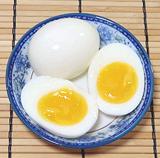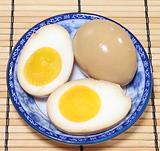|
|
ar
ar
|
|
Eggs (1)
Water
|
Do these in small batches, 4 to 6 eggs so you have tight control. Always
do more than you need as you may have one or more that don't peel well.
Run - (15 min)
- Pierce EGGS on the big end - doesn't help for peeling, but does
help to prevent bursting.
- Important: this step makes the eggs more peelable, breaking the
undershell membrane from the egg white.
In a sauce pan, bring plenty of water to a rolling boil. Set Eggs
in the water for 30 to 40 seconds over high heat. Pour out as much water
as you can, and chill eggs with a splash of cold water. Pour that out and
fill the pan with cold water to 1/2 inch over the eggs.
- Place pan on high heat. Bring up to a full boil (eggs will start to
rattle around and bubble rise) immediately turn off the heat.
- Time you eggs precisely. For Medium Eggs, about 2 minutes for yolks
quite liquid, 2-1/2 minutes for jelly with a little liquid in the center
and slight setting on the outer surface. By 3 minutes yolk will be
completely solid and flavor will have changed substantially. Large eggs
will take about 30 seconds longer.
- Immediately, stop the cooking by pouring out the hot water while
pouring in cold water. After a couple of changes of water, let them
cool thoroughly.
- Crack the shell against your cutting board and peel off the shell, very
gently and patiently, as the whites are still tender. Doing it under cold
running water may help.
- Place Eggs in a bowl of cold water so they float and stay round.
|



